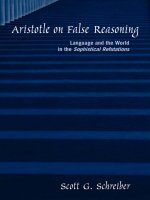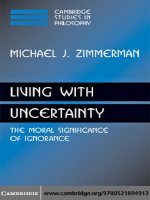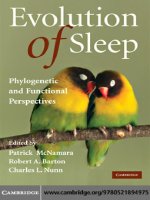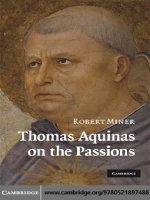0521823285 cambridge university press aristotle on truth oct 2004
Bạn đang xem bản rút gọn của tài liệu. Xem và tải ngay bản đầy đủ của tài liệu tại đây (1.79 MB, 354 trang )
This page intentionally left blank
ARISTOTLE ON TRUTH
Aristotle’s theory of truth, which has been the most influential account
of the concept of truth from Antiquity onwards, spans several areas
of philosophy: philosophy of language, logic, ontology, and epistemology. In this book, the first dedicated to this topic, Paolo Crivelli
discusses all the main aspects of Aristotle’s views on truth and falsehood. He analyses in detail the main relevant passages, addresses some
well-known problems of Aristotelian semantics, and assesses Aristotle’s
theory from the point of view of modern analytic philosophy. In the
process he discusses most of the literature on Aristotle’s semantic
theory to have appeared in the last two centuries. His book vindicates and clarifies the often repeated claim that Aristotle’s is a correspondence theory of truth. It will be of interest to a wide range of
readers working in both ancient philosophy and modern philosophy
of language.
paolo c r i vel l i is Fellow and Tutor in Classical Philosophy at
New College, Oxford. He has published articles on Plato’s logic and
epistemology, Aristotle’s philosophical logic, and Stoic logic.
A R I S TOT L E O N T RU T H
PA O L O C R I V E L L I
University of Oxford
cambridge university press
Cambridge, New York, Melbourne, Madrid, Cape Town, Singapore, São Paulo
Cambridge University Press
The Edinburgh Building, Cambridge cb2 2ru, UK
Published in the United States of America by Cambridge University Press, New York
www.cambridge.org
Information on this title: www.cambridge.org/9780521823289
© Paolo Crivelli 2004
This publication is in copyright. Subject to statutory exception and to the provision of
relevant collective licensing agreements, no reproduction of any part may take place
without the written permission of Cambridge University Press.
First published in print format 2004
isbn-13
isbn-10
978-0-511-23002-8 eBook (EBL)
0-511-23002-8 eBook (EBL)
isbn-13
isbn-10
978-0-521-82328-9 hardback
0-521-82328-5 hardback
Cambridge University Press has no responsibility for the persistence or accuracy of urls
for external or third-party internet websites referred to in this publication, and does not
guarantee that any content on such websites is, or will remain, accurate or appropriate.
To the memory of my father
Renzo Crivelli
and to my mother
Katherine Lester Crivelli
Contents
Acknowledgements
Notes on the text
List of abbreviations of titles of Aristotle’s works
Introduction
page ix
x
xi
1
1 An overview of Aristotle’s theory of truth
2 Methodology
1
39
part i bearers of truth or falseho od
1 States of affairs, thoughts, and sentences
1 States of affairs
2 Thoughts
3 Sentences
46
62
72
2 Truth conditions for predicative assertions
1
2
3
4
5
Universals
Truth and falsehood in de Interpretatione 1
Affirmative and negative predicative assertions
Assertions about individuals vs assertions about universals
Truth and the categories
3 Truth conditions for existential assertions
1 Existential assertions concerning simple items
2 Non-composite substances
3 Singular existential assertions concerning material substances
part ii
45
77
78
82
86
89
95
99
100
116
121
‘em pt y’ terms
4 Truth as correspondence
129
1 A correspondence theory of truth?
2 The Liar
129
139
vii
viii
Contents
5 ‘Vacuous’ terms and ‘empty’ terms
152
1 ‘Vacuous’ subjects or predicates
2 ‘Empty’ subjects or predicates
3 One assertion vs many assertions
153
158
163
part iii
truth and time
6 Truth and change
183
1 Different truth-values at different times
2 Truth and relatives
3 How far is truth from change?
7 Truth and Determinism in de Interpretatione 9
1 The modal attributes and theses involved in Int. 9
2 Close textual analysis of Int. 9
3 Alternative interpretations
183
189
194
198
199
200
226
Appendix 1 Metaph.
10, 1051b 1: the text
234
Appendix 2
Metaph.
10, 1051b 2–3: the text
238
Appendix 3
Int. 7, 17b 16–18: the text
239
Appendix 4
The two-place relations in Aristotle’s
definition of truth
254
Aristotle’s theory of truth for predicative
assertions: formal presentation
258
The failure of Bivalence for future-tense
assertions: formal presentation
266
Appendix 5
Appendix 6
References
Index of names
Index of subjects
Index of passages
284
313
319
321
Acknowledgements
Many friends and colleagues helped me to shape my views on many of the
issues addressed by this study, and alerted me to points where improvement
was desirable. Early drafts of parts of the book were presented in Cambridge,
Clark, Edinburgh, Florence, Liverpool, Oxford, and Pisa. Among the individuals who in various ways helped me to bring this project to completion,
I should like to mention Francesco Ademollo, Francesco Adorno, Fabrizio Amerini, Sylvia Berryman, Susanne Bobzien, Ettore Casari, Walter
Cavini, David Charles, Francesco Del Punta, Paolo Fait, Michael Frede,
Gabriele Galluzzo, Richard Gaskin, Katerina Ierodiakonou, Fred Miller,
Peter Milne, Ben Morison, Massimo Mugnai, David Robinson, Gonzalo
Rodriguez-Pereyra, Theodore Scaltsas, Annamaria Schiaparelli, David Sedley, Bob Sharples, Robin Smith, Christopher Strachan, John Thorp, Tim
Williamson, and an anonymous referee for Cambridge University Press.
The responsibility for the remaining shortcomings is of course mine alone.
ix
Notes on the text
‘LSJ’ abbreviates the Liddell, Scott, Jones Greek–English lexicon.
I refer to Aristotelian passages by the line numbers as they are printed in
Bekker’s original edition: these in some cases differ from the ‘Bekker lines’
of widespread editions (e.g., 101b 38 of Ross’s edition of the Topics is 101b 39
of Bekker’s original edition). Similarly, I follow Bekker’s numbering of the
chapters within each book of the Nicomachean Ethics.
For Greek authors I use LSJ’s standard abbreviations. For authors other
than Aristotle, I normally use the critical editions on which LSJ relies. For
Latin authors, I employ abbreviations which are easy to decode and I use
standard critical editions.
‘Cf.’ at the beginning of a footnote indicates that the passages subsequently referred to express views close to those formulated in the portion
of the main text to which the footnote pertains. If I disagree with an author,
I say so explicitly (I never use ‘cf.’ to refer to one or more passages that formulate views with which I disagree).
I use quotation marks for three purposes: (i) to mention linguistic expressions, e.g. the word ‘dog’ is a noun; (ii) to indicate that a certain linguistic
expression is being used in some special or unusual sense, e.g. Homer is a
‘philosopher’; (iii) to quote a portion of text from some author, e.g. Aristotle says that ‘sentences are true in the same way as the objects’ (Int. 9, 19a 33).
I use double quotation marks (“and”) only when what would otherwise be
occurrences of single quotation marks would be embedded within single
quotation marks.
x
Abbreviations of titles of Aristotle’s works
APo.
APr.
Cael.
Cat.
de An.
Div. Somn.
EE
EN
GA
GC
HA
Insomn.
Int.
Long.
MM
Mem.
Metaph.
PA
Ph.
Po.
Pol.
Pr.
Rh.
SE
Sens.
Somn. Vig.
Top.
Xen.
Posterior Analytics
Prior Analytics
de Caelo
Categories
de Anima
de Divinatione per Somnia
Eudemian Ethics
Nicomachean Ethics
de Generatione Animalium
de Generatione et Corruptione
Historia Animalium
de Insomniis
de Interpretatione
de Longaevitate
Magna Moralia
de Memoria
Metaphysics
de Partibus Animalium
Physics
Poetics
Politics
Problems
Rhetoric
Sophistici Elenchi
de Sensu
de Somno et Vigilia
Topics
de Xenophane
xi
Introduction
The study of truth is a central part of the philosophical tradition we have
inherited from classical Greece. Aristotle played an important role in developing and sharpening the debate in this area and on many issues that are
connected with it. I have two primary goals: to offer a precise reconstruction
of all of Aristotle’s most significant views on truth and falsehood and to gain
a philosophical understanding of them. In this introduction I first offer an
overview of Aristotle’s theory of truth and then discuss the methodology I
adopt in pursuing my primary goals.
1 an overview of aristotle’s theory of t ruth
Why an overview? Aristotle speaks about truth and falsehood in passages
from several works, mainly the Categories (chapters 4, 5, 10, and 12), de Interpretatione (chapters 1–9), Sophistici Elenchi (chapter 25), de Anima (chapter
3.6), and the Metaphysics (chapters 7, 7, 29, E 4, and 10). Truth
and falsehood are not the main topic of these works: their discussions of
truth and falsehood are asides. Reconstructing an Aristotelian theory of
truth and falsehood on the basis of such asides poses complicated problems
of various sorts. To help readers to keep their orientation through the many
bifurcations of the arguments addressing these problems, I decided to offer
a concise but precise map of the territory – an overview of Aristotle’s theory
of truth. References to the passages from Aristotle’s works that substantiate
the attribution of a certain view to him, and an examination of the relevant secondary literature, will be found in the chapters that follow this
introduction.
Universals. To expound Aristotle’s theory of truth, I need to present some
of his views on universals and signification. I begin with universals.
Luckily, it is not necessary to embark on the daunting task of a complete exposition of Aristotle’s views on universals. Aristotle is to this extent
1
2
Introduction
a realist about universals: in his view, universals are objects whose nature
is neither mental nor linguistic (they are neither concepts nor linguistic expressions). He believes that every universal exists when and only
when1 it holds of some individual or other that at some time or other
exists.2
Let me spend a few words explaining why the phrase ‘at some time or
other’ is needed. According to Aristotle, some universals sometimes hold
of individuals that do not exist then, but exist at other times. For example,
Aristotle seems to think that at any time the universal poet3 holds of all
and only those individual human beings (including those who at that time
do not exist) who by that time have authored some poem. In particular,
Aristotle would probably grant that although Homer does not exist now,
the universal poet holds now of Homer. It is because of universals of this
sort that the phrase ‘at some time or other’ is needed.
Aristotle is likely to believe that every universal is everlasting, i.e. exists
always. Hence he is likely to be committed to the view that every universal
at all times holds of some individual or other that at some time or other
exists – in short, that all universals are always instantiated. This of course
leaves the possibility open that every individual that at some time or other
exists and of which a certain universal holds at one time could be other than
every individual that at some time or other exists and of which the same
universal holds at a certain other time – in short, the possibility remains that
some universal could be instantiated by different individuals at different
times.
Signification. I now move on to expound some of Aristotle’s views on signification. Aristotle thinks that some utterances of certain noun-phrases and
certain adjectival phrases signify a single universal: e.g. he would grant that
some utterances of ‘man’ signify the universal man and that some utterances
of ‘white’ signify the universal white. He also thinks that some utterances
of certain noun-phrases signify a single individual: e.g. he would grant that
some utterances of ‘Socrates’ signify Socrates, the Athenian philosopher
executed in 399 bc. However, he believes that some utterances of certain
1
2
3
I use ‘when and only when’ in a strictly temporal sense, i.e. as equivalent to ‘at all and only the times
at which’.
I use ‘to hold of ’ to express the relation of a universal to its instances. Following Aristotle’s lead, I
sometimes use ‘to be predicated of ’ to express this same relation.
I normally refer to a universal by simply using a linguistic expression that signifies it (if this linguistic
expression is a phrase, I hyphenate it); I avoid referring to a universal by italicising, or enclosing in
quotation marks, a linguistic expression that signifies it. For example, I normally refer to universals
by means of expressions like ‘the universal poet’ or ‘the universal man-who-authored-a-poem’; I avoid
referring to universals by means of expressions like ‘the universal poet’ or ‘the universal “poet”’.
Introduction
3
noun-phrases and some of certain adjectival phrases signify neither a single
universal nor a single individual: e.g. he would concede that some utterances of ‘walking white man’ or ‘walking, white, and tall’ signify neither
a single universal nor a single individual (he would claim that each of
these utterances signifies many universals which do not coalesce in a single
universal).
What can be true or false? Having presented Aristotle’s views on universals
and signification that are necessary to understand his theory of truth, I am
in a position to begin addressing the main themes of the latter. Let me start
with Aristotle’s conception of the bearers of truth or falsehood.
According to Aristotle, items that are true or false are of three main
kinds: sentences, thoughts, and certain objects whose nature is neither
mental nor linguistic. The sentences that are true or false are sentencetokens, utterances, events of speech that occur over relatively short portions
of time. Similarly, the thoughts that are true or false are thought-tokens,
either mental events that occur over relatively short portions of time or
thinker-individuated mental states.
For Aristotle, events of perceiving and imagining also are true or false.
Events of perceiving and imagining fall under none of the three kinds I just
mentioned: they are neither thoughts, nor sentences, nor objects whose
nature is neither mental nor linguistic. Since Aristotle’s views on the truth
and falsehood of events of perceiving and imagining are somewhat isolated
from the rest of his reflection on truth and falsehood, in this introduction
I shall say nothing more about them.
A puzzling view. A particularly puzzling part of Aristotle’s theory of truth is
his view that among items that are true or false there are objects (I sometimes
use ‘object’ to mean ‘object whose nature is neither mental nor linguistic’:
I trust that the context will make it clear whether a given occurrence of
‘object’ is to be understood in this narrow sense). On this point Aristotle’s
theory of truth is radically different from some modern ones: modern
philosophers are ready to acknowledge that certain thoughts or sentences
are true or false, but some of them would jib at the suggestion that some
objects are true or false.
These objects that are true or false occupy a central position in Aristotle’s
theory of truth. What are they? What roles do they play in Aristotle’s theory
of truth?
What are the objects that are true or false? Aristotle distinguishes two kinds
of objects that are true or false: composite objects and simple objects.
4
Introduction
Some composite objects that are true or false are states of affairs.4 A state
of affairs, which is an object, is composed of two further objects: one of the
objects of which it is composed is a universal, the other is either a universal or
an individual. A state of affairs is true when and only when the objects of
which it is composed are reciprocally combined in the relevant way; it is
false when and only when the objects of which it is composed are reciprocally divided in the relevant way.5 For example, the state of affairs that
Socrates is seated is composed of the universal seated and of the individual
Socrates; it is true when and only when the universal seated is combined in
the relevant way with Socrates, i.e. when and only when Socrates is seated;
it is false when and only when the universal seated is divided in the relevant
way from Socrates, i.e. when and only when Socrates is not seated. Again,
the state of affairs that every diagonal is commensurable is composed of
the universal commensurable and of the universal diagonal; it is true when
and only when the universal commensurable is combined in the relevant
way with the universal diagonal, i.e. when and only when every diagonal is
commensurable; it is false when and only when the universal commensurable is divided in the relevant way from the universal diagonal, i.e. when
and only when some diagonal is not commensurable. Since no diagonal
ever is commensurable, the state of affairs that the diagonal is commensurable is never true but always false. Aristotle allows only ‘affirmative’ states
of affairs: among states of affairs there are the state of affairs that Socrates
is seated and the state of affairs that every diagonal is commensurable, but
there is not a state of affairs that Socrates is not seated nor is there one that
not every diagonal is commensurable. In principle, a state of affairs can
exist at a time when it is false, i.e. at a time when the objects of which it
is composed are reciprocally divided in the relevant way. For example, the
state of affairs that Socrates is seated exists at certain times when it is false;
again, the state of affairs that every diagonal is commensurable always exists
and is always false. The combination that makes a state of affairs true is not
to be confused with the composition whereby the state of affairs is composed of further objects. By the same token, the division that makes a state
of affairs false does not destroy the composition whereby the state of affairs
is composed of further objects (otherwise the state of affairs could not, even
in principle, exist at any time when it is false). For example, the state of
4
5
‘State of affairs’ can be used in several senses. I use it to denote objects of a ‘propositional’ nature of
which it is sensible to say both that they obtain and that they do not obtain at a time.
‘To be combined’ and ‘to be divided’ are technical expressions. I hope that the examples in this
paragraph’s sequel will provide an intuitive grasp of their meaning. They will be discussed in greater
detail later in this introduction.
Introduction
5
affairs that Socrates is seated remains composed of the universal seated and
of the individual Socrates even when the universal seated is divided from
the individual Socrates in such a way as to make the state of affairs in question false. It remains unclear whether in Aristotle’s view all states of affairs
are everlasting: does Aristotle believe that the state of affairs that Socrates
is seated exists both before and after Socrates exists? A state of affairs, as it
is conceived of by Aristotle, is best understood as an object corresponding
to a complete present-tense affirmative predicative assertion, and as being
composed of the objects signified by the assertion’s predicate and subject.
For example, the state of affairs that Socrates is seated corresponds to the
whole present-tense affirmative predicative assertion that is an utterance
of ‘Socrates is seated’, and is composed of the universal seated, which is
signified by the assertion’s predicate (an utterance of ‘seated’), and of the
individual Socrates, who is signified by the assertion’s subject (an utterance
of ‘Socrates’).
As I said, some composite objects that are true or false are states of
affairs. According to Aristotle, material substances (e.g. Socrates and the
horse Bucephalus) are composite objects in that they consist of form and
matter. Material substances are not states of affairs, but they resemble states
of affairs in interesting respects: as for a state of affairs to be true is to
be combined, so for a material substance to exist is to be combined, i.e.
it is for its form to be combined with its matter; as for a state of affairs
to be false is to be divided, so for a material substance not to exist is to
be divided, i.e. it is for its form to be divided from its matter. Aristotle
perhaps thinks that material substances rank among the composite objects
that are true or false, that for a material substance to be true is to exist,
and that for a material substance to be false is not to exist. I can use only
the cautious expression ‘Aristotle perhaps thinks . . .’ because the evidence
for attributing the position in question to Aristotle is far less than clear cut.
However, independently of whether Aristotle does endorse the position
in question, at least two differences between states of affairs and material
substances are worth noting. First, while some state of affairs exists at times
when it is false, no material substance exists at times when it is false (because,
according to the position in question, for a material substance to be false
is not to exist). Second, although some material substances (i.e. celestial
bodies) are everlasting, most are not; on the other hand, Aristotle does not
state how long states of affairs exist, but his position might well be that all
states of affairs are everlasting.
Since a simple object has no components between which combination
or division could obtain, for a simple object to be true cannot be to be
6
Introduction
combined, nor can for it to be false be to be divided. Rather, for a simple
object to be true is simply to exist, and for it to be false is simply not
to exist. Aristotle distinguishes two kinds of simple objects: essences and
incorporeal substances. Essences are natural kinds (e.g. the kind horse).6
The remaining simple objects, incorporeal substances, are God and (perhaps) the intellects that move the heavenly spheres.7 The application of
‘true’ to incorporeal substances should not arouse wonder: ‘true’ is one of
the epithets traditionally used to speak of God. Both essences and incorporeal substances are everlasting, i.e. exist always. Hence, all simple objects
exist always.
The sense of ‘true’ and ‘false’ whereby they apply to objects is probably
Aristotle’s own creation: it is an extension of the ordinary sense of these
expressions which Aristotle introduces in order to construct a better theory
of truth. It is not, however, completely unconnected with ordinary usage:
‘true’ can be used (both in Greek and in English) to mean ‘real’ (as in ‘true
coin’), and ‘real’ is connected with ‘existent’ (although ‘real’ and ‘existent’
are used differently, one can employ the phrase ‘the contrast between dreams
and what is real’ to describe the discrepancy between what exists and what
someone would like to exist).
Aristotle’s views on the nature of the bearers of truth or falsehood can
now be conveniently summarised by the following schema:
bearers of truth or falsehood
sentences
thoughts
objects whose nature is
neither mental nor linguistic
composite
states of
affairs
6
7
simple
material
substances (?)
essences
incorporeal
substances
Aristotle’s remarks on essence are difficult to understand and are variously interpreted. The view I am
attributing to Aristotle here, i.e. that essences are natural kinds, is ‘minimal’ in that it is compatible
with, and perhaps implied by, several of these interpretations.
By ‘material’ and ‘immaterial’ I mean ‘containing matter’ and (respectively) ‘not containing matter’.
By ‘corporeal’ and ‘incorporeal’ I mean ‘either containing or mixed with matter’ and (respectively)
‘neither containing nor mixed with matter’. Thus: Socrates is a material and corporeal substance;
Socrates’ essence is an immaterial but corporeal substance; God is an immaterial and incorporeal
substance.
Introduction
7
What roles do the objects that are true or false play in Aristotle’s theory of truth?
Objects that are true or false play three roles in Aristotle’s theory of truth:
first, they contribute to explaining what it is to be true or false for items
of other kinds which can be such, i.e. for thoughts and sentences; second,
they are bearers of modal attributes; third, they are targets of propositional
attitudes. In the following subsections I shall examine these three roles in
turn.
The first role of objects that are true or false: contributing to explaining what
it is to be true or false for thoughts and sentences. As I just said, the first
role played in Aristotle’s theory of truth by objects that are true or false is
to contribute to explaining what it is to be true or false for thoughts and
sentences. This role recalls a strategy which is often adopted in modern
philosophy of logic, from Frege onwards: that of explaining the truth and
falsehood of certain mental states and certain sentences by appealing to the
truth and falsehood of propositions (abstract entities whose nature is neither
mental nor linguistic). Although there are important differences between
Aristotle’s conception and the modern strategy, at this stage I would like to
call attention to the resemblance.
To expound how objects that are true or false contribute to explaining
what it is to be true or false for thoughts and sentences, I must say something about Aristotle’s views on thoughts and sentences that are true or
false.
Truth-evaluable sentences. Not every sentence is either true or false: some
are neither (e.g. prayers). Every sentence that is true or false is an assertoric
sentence, or (as Aristotle often calls it) an assertion. But the converse fails:
some assertions are neither true nor false (read on to find out which).
Assertions coincide with truth-evaluable sentences, i.e. with the sentences
with regard to which the question ‘Is it true or false?’ can be reasonably
asked. Note that this question cannot be reasonably asked with regard to
certain sentences (e.g. prayers). In the case of some sentences with regard to
which the question ‘Is it true or false?’ can be reasonably asked, the correct
answer is ‘Neither’. An analogy helps to clarify. Physical objects coincide
with colour-evaluable objects, i.e. with the objects with regard to which
the question ‘What colour is it?’ can be reasonably asked. Note that this
question cannot be reasonably asked with regard to certain objects (e.g.
numbers). In the case of some objects with regard to which the question
‘What colour is it?’ can be reasonably asked, the correct answer is ‘None’
(e.g. some transparent objects like crystal balls or diamonds).
8
Introduction
Assertions are utterances, i.e. expression-tokens (not expression-types),
events of speech that occur over relatively short portions of time.
Truth-evaluable thoughts. Aristotle does not explicitly isolate a class of truthevaluable thoughts that constitute the mental counterparts of assertions.
However, since he regards the spheres of thought and speech as closely
analogous, indeed, almost as isomorphic, he is likely to believe that there
is such a class of truth-evaluable thoughts corresponding to the class of
truth-evaluable sentences, i.e. to the class of assertions.
Some of Aristotle’s remarks indicate that he would agree that every belief
is a truth-evaluable thought, i.e. a thought with regard to which the question ‘Is it true or false?’ can be reasonably asked. However, I doubt that
Aristotle would claim that every truth-evaluable thought is a belief. Hence,
for Aristotle beliefs probably constitute a proper subclass of truth-evaluable
thoughts. I guess Aristotle would grant that not every belief is either true
or false.
Simple and composite assertions. Aristotle distinguishes two kinds of
assertions: simple assertions and composite assertions. An assertion is simple just in case it concerns exactly one object; it is composite just in case it
concerns more than one object. Every simple assertion is either affirmative
or negative. Composite assertions are equivalent to utterances constructed
from several assertions linked by connective particles.
Aristotle concentrates on simple assertions, i.e. assertions that concern
exactly one object. He has little to say about composite assertions: he
acknowledges their existence, but they remain at the margins of his reflection. He never states that some sentences that are true or false have no
assertoric force (like the utterance of ‘Socrates is seated’ which is a part of
an utterance of ‘Either Socrates is seated or Socrates is not seated’). Nor
does he discuss utterances of ‘Either Socrates is seated or Socrates is seated’:
are they simple (because they concern exactly one object, i.e. the state of
affairs that Socrates is seated) or composite (because they are disjunctive)?
Simple beliefs. Aristotle does not explicitly isolate a class of simple beliefs
that are the mental counterparts of simple assertions. However, since (as
I said) he regards the spheres of thought and speech as closely analogous,
he is likely to take such a class for granted: he probably thinks that simple
beliefs are those beliefs that concern exactly one object, and that every
simple belief is either affirmative or negative.
Introduction
9
A general definition of truth and falsehood for simple beliefs and assertions.
Having expounded Aristotle’s views on thoughts and sentences that are
true or false, I am now in a position to address his conception of how
objects that are true or false contribute to explaining what it is to be true or
false for thoughts and sentences. Objects play this role, in particular, with
regard to simple beliefs and simple assertions.
Aristotle’s theory of truth and falsehood for simple beliefs and assertions
is governed by a general definition of truth and falsehood (henceforth
‘DTF’):
DTF Every simple belief, or assertion, concerns exactly one object and
is either affirmative or negative. Every affirmative simple belief, or
assertion, posits that the object it concerns is true. Accordingly, an
affirmative simple belief, or assertion, is true when and only when the
object it concerns is true; an affirmative simple belief, or assertion,
is false when and only when the object it concerns is false. Every
negative simple belief, or assertion, posits that the object it concerns
is false. Accordingly, a negative simple belief, or assertion, is true
when and only when the object it concerns is false; a negative simple
belief, or assertion, is false when and only when the object it concerns
is true.
DTF is a definition of truth (at least for simple beliefs and assertions).
Aristotle does not address the issue of the criterion of truth (roughly, the
issue of establishing what, if any, reliable ways humans have of discovering
truths). Aristotle’s silence on the issue of the criterion of truth is remarkable
in view of the fact that shortly after his death, with the advent of the
Hellenistic philosophical schools of the third and second centuries bc, this
issue becomes a hot topic of philosophical debate.
DTF covers at one blow all simple beliefs and assertions, those concerning
composite objects as well as those concerning simple ones. It is worthwhile
working out the details of Aristotle’s account for each case. So, let us examine
the forms taken on by DTF with simple beliefs and assertions concerning
composite objects and with simple beliefs and assertions concerning simple
objects. However, there are two kinds of composite objects: states of affairs
and material substances. Let us then study the forms of DTF with regard
to simple beliefs and assertions concerning (i) those composite objects that
are states of affairs, (ii) those composite objects that are material substances,
and (iii) simple objects.
10
Introduction
Predicative assertions and beliefs. The simple assertions which concern those
composite objects that are states of affairs are predicative assertions; similarly, the simple beliefs that concern those composite objects that are states
of affairs are predicative beliefs. Let me first spend a few paragraphs explaining Aristotle’s views on predicative assertions and predicative beliefs.
Predicative assertions display a subject–predicate structure (this can be
clearly seen in examples of predicative assertions like utterances of the
sentence-type ‘Socrates is seated’ or of the sentence-type ‘Socrates is not
seated’). Every predicative assertion has at least three parts: the predicate,
the subject, and the copula. In every predicative assertion, the predicate
signifies a universal, the subject signifies either a universal or an individual,
and the copula combines with the predicate to form a predicative expression. Consider a predicative assertion that is an utterance of ‘Socrates is
seated’: the predicate is the part of the assertion that is an utterance of the
adjective ‘seated’ and signifies the universal seated; the subject is the part
of the assertion that is an utterance of the name ‘Socrates’ and signifies the
individual Socrates; and the copula is the part of the assertion that is an
utterance of ‘is’ and combines with the predicate to form the predicative
expression that is an utterance of ‘is seated’. Every predicative assertion is
either affirmative (e.g. an utterance of ‘Socrates is seated’) or negative (e.g.
an utterance of ‘Socrates is not seated’). Many predicative assertions have
further parts over and above the predicate, the subject, and the copula: they
contain utterances either of a negative particle (an utterance of ‘not’, as in
an utterance of ‘Socrates is not seated’) or of a quantifying expression (an
utterance of ‘every’, ‘no’, ‘some’, or ‘not every’, as in an utterance of ‘No
horse is white’). Many assertions that contain no copula are regarded by
Aristotle as equivalent to assertions that do contain one: e.g. for Aristotle
an utterance of ‘Socrates walks’ is equivalent to one of ‘Socrates is walking’.
Note that in English ‘Socrates is walking’ is not equivalent to ‘Socrates
walks’. Aristotle’s view, however, is correct with respect to Greek usage: the
Greek sentence-type rendered by ‘Socrates is walking’ is in fact equivalent
to that rendered by ‘Socrates walks’.
A predicative belief is a belief whose literal linguistic expression would
be a predicative assertion. For example, Plato’s belief that Socrates is seated
is a predicative belief because its literal linguistic expression would be
a predicative assertion that is an utterance of ‘Socrates is seated’. Every
predicative belief has a part that constitutes its predicate (it is about, or
concerns, or – as I shall often say – grasps a universal) and one that
constitutes its subject (it grasps either a universal or an individual). For
example, in Plato’s belief that Socrates is seated, the predicate is the part
Introduction
11
of the belief that grasps the universal seated, the subject is the part that
grasps the individual Socrates. Every predicative belief is either affirmative
(e.g. Plato’s belief that Socrates is seated) or negative (e.g. Simmias’ belief
that Socrates is not seated). Note that the predicate and the subject of
a predicative assertion are utterances, and they signify objects; the predicate and the subject of a predicative belief are thoughts, and they grasp
objects.
Aristotle’s classification of predicative beliefs and assertions. Aristotle has a
richly articulated classification of predicative beliefs and assertions. Predicative beliefs and assertions divide into two main groups: singular and
general predicative beliefs and assertions. A predicative belief, or assertion,
is singular just in case its subject grasps, or signifies, an individual; it is
general just in case its subject grasps, or signifies, a universal. Examples
of singular predicative assertions are utterances of ‘Socrates is seated’ and
‘Socrates is not seated’. As for general predicative beliefs and assertions, they
divide into two subordinate groups: indeterminate and quantified predicative beliefs and assertions. Examples of indeterminate predicative assertions
are utterances of ‘A horse is white’ and ‘A horse is not white’. As for quantified predicative beliefs and assertions, they divide into two subordinate
groups: particular and universal predicative beliefs and assertions. Examples of particular predicative assertions are utterances of ‘Some horse is
white’ and ‘Not every horse is white’; examples of universal predicative
assertions are utterances of ‘Every horse is white’ and ‘No horse is white’.
Aristotle’s classification of predicative beliefs and assertions is conveniently
summarised by the following schema:
predicative beliefs and assertions
singular
general
indeterminate
quantified
particular
universal
The distinction between affirmative and negative predicative beliefs and
assertions cuts across the above classification: every group within this









